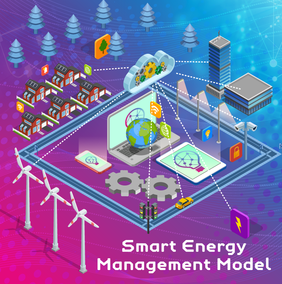Following kick-off, SMARCTIC has seen the development of its first project output in a ‘SMART Energy Management Model’ (SEMM). Representatives from all the partner regions collaborated to formulate a robust model that is adaptable for the varying needs of the Northern Periphery and Arctic (NPA) Regions.
Energy management systems are integral to improving the balance of energy supply and demand in an efficient way. There are two sides to this; supply side and demand side, where consumers manage their energy consumption in order to meet the available power from the generation and supply side. The main goal of energy management is to reduce the cost of operation and consumption, reduce energy losses and increase the reliability of the network, whilst also integrating renewable solutions. Energy management possesses many challenges. Traditionally, control of generation units and consuming appliances was manual or used basic control systems. In modern time, with the development of ICT control systems, sophisticated algorithms and with the integration of information & communication technologies, SMART Energy Management Models can be developed to better manage the energy that is available to communities.
The SMARCTIC approach was to develop a model that met two distinctive criteria; a model that focused on stocks of buildings within a specific geographic area; and a general modular solution that could be adapted to meet the needs of stakeholders and communities in different NPA regions. The focus on managing energy consuming buildings and infrastructure within a specific geographically bound community required a new type of solution that was adapted from existing smart city models, and embraced SMART technology such as Artificial Intelligence (AI) and Internet of Things (IoT). The second criteria required capitalization of the knowledge available in the transnational cooperation as there is no such model that exists in any single NPA Region. Through the project partners, this output brought together the various specialisms of different regions, such as AI in Derry and the IoT in Lapland. This has allowed for goals that could not be efficiently reached at national, regional or local level due to absence of transnational partners, to be achieved.
The newly developed SEMM provides a common platform to facilitate long-term energy cooperation by communities across the NPA and facilitates new innovative energy services to be piloted as they emerge. The solution is primarily envisaged as an integrated energy communications channel between the public authority – responsible for decreasing overall energy usage in their community – and the energy consumers (homes, businesses, public infrastructures). Through an interactive dashboard, energy consumers will have the potential to view their own and their community’s overall energy usage. Using the latest visualisation techniques, they can then model the impact of consumer demand & behaviour, and also different weather conditions. In addition, they will have access to tools which allow them to simulate the impact of changes in behaviour on their energy efficiency. The SEMM will also provide a platform for companies in the energy services sector and universities to test demand for new services and conduct research, respectively. They will also be able to monitor – and express an interest in the progress of the various smart energy pilots being carried out by the project in their own and other areas.
The developed SEMM organises the various enabling, system-level and physical-level technologies that are required to gather, storage, analyse and disseminate energy information. The model will be adapted and deployed in six various pilots within the NPA region. It provides for an intangible, yet crucial element of the SMARCTIC project’s main aim to provide NPA regions with enhanced capacity to deliver high-quality and integrated energy efficiency and renewable energy solutions in their communities.

